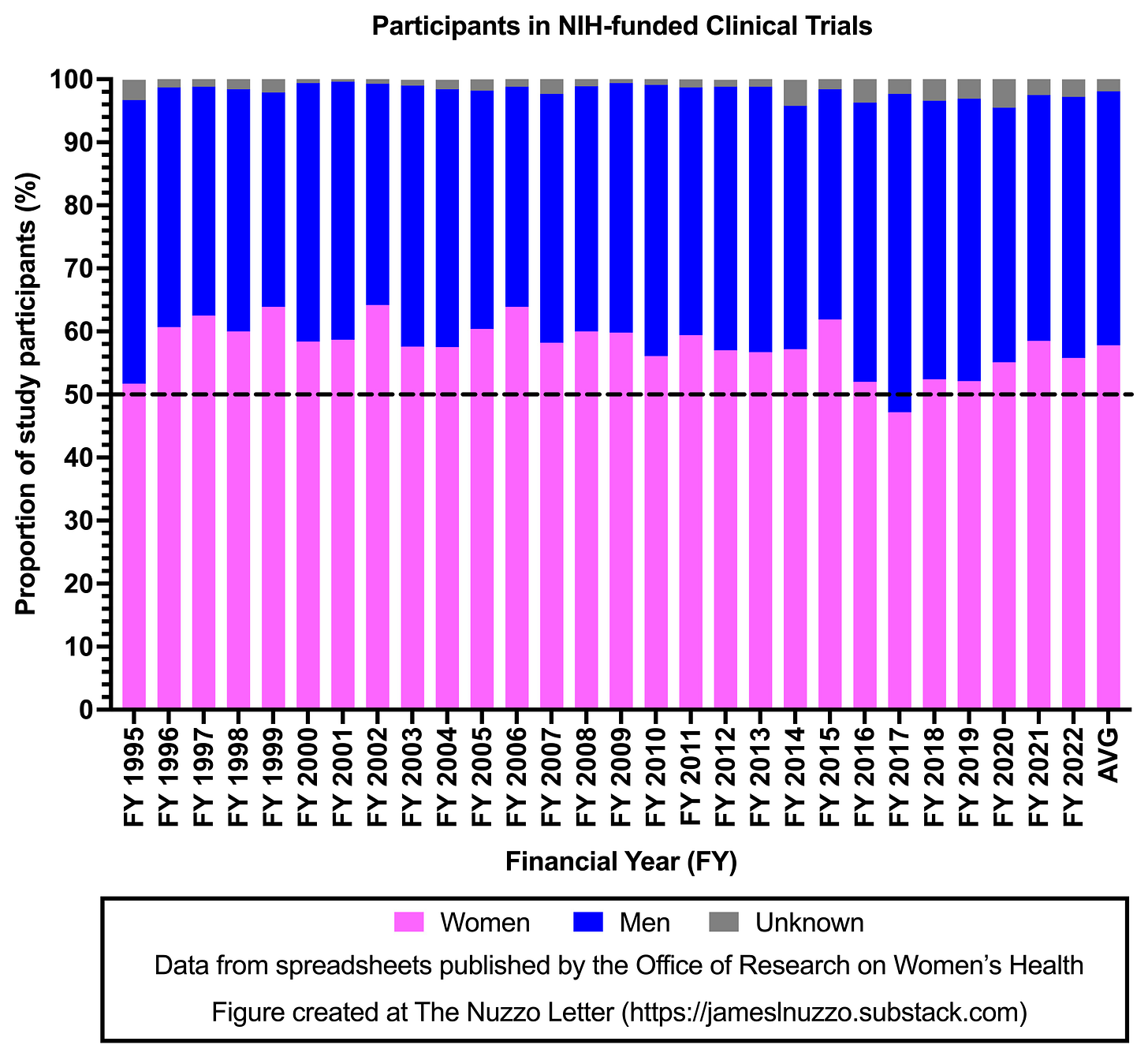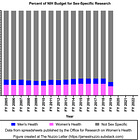Women Are Not "Understudied" or "Underrepresented" in Medical Research
This List of Government Reports Proves It

The claim that women have been “understudied” or “underrepresented” in medical research can be found in many contemporary sources, including Forbes Magazine, Time Magazine, The Washington Post, Inside Higher Ed, and the list goes on and on. This claim is also made by organizations like the American Physiological Society (see image below), the Society for Women’s Health Research, and the Association of American Medical Colleges, and it served as part of the rationale for the creation of the Biden White House’s Initiative on Women’s Health Research. Sometimes, the claim is broad and sweeping; other times, it is more nuanced and targeted at specific types of health research. The broad claim that women have been historically “understudied” or “underrepresented” in medical research is false.
Previously, I published a graph showing the percentage of individuals who participated in National Institutes of Health (NIH)-funded clinical trials1 between 1995 and 2022 who were male and female. Averaged over the 28-year period, females made up 58% of participants in NIH-funded research trials. Females made up over 50% of participants every year except 2017.
The data presented in the graph were extracted (by me) from reports published by the NIH’s Office of Research on Women’s Health (ORWH). Given the strength of the narrative regarding the “historical exclusion of women” from research, one can understand how some individuals might still have some have uncertainties or scepticisms about the data in the graph – i.e., where the data came from and whether they were extracted and presented accurately. Moreover, government reports sometimes disappear into the abyss of government documents that are archived online. Consequently, they are difficult to find with traditional keywords searches, and this particularly for individuals who are unaccustomed to searching for such data or navigating government webpages. Also, hyperlinks on government websites sometimes lead to broken webpages. With periodic turnovers in government administrations, staffing, resourcing, and priorities, issues with broken webpages is likely to continue.
Therefore, to ensure that the validity of the data in the graph is upheld over time, I have collated and uploaded pdfs of government reports that have presented data on the proportion of males and females who participated in NIH-funded research trials from the 1990s until today. The reports often overlap, showing participation representations across many of the same years. Such overlap solidifies the reliability and validity of the data.
The reports come from two related sources. The first source is the NIH’s Office of Research on Women’s Health (ORWH). As of this writing, these ORWH reports are all indexed here. The second is the NIH but not specifically ORWH. As of this writing, these NIH reports are all indexed here.
I have also linked a peer-reviewed paper from 2001 titled, Did medical research routinely exclude women? An examination of the evidence. The author of the paper is Ed Bartlett. Bartlett is a former employee of the U.S. Department of Health and Human Services, founder of Stop Abusive and Violent Environments and the Coalition to End Domestic Violence and current president of the International Council for Men and Boys. In the paper, Bartlett searched medical research databases to identify the number of males and females who participated in clinical trials and epidemiological studies from the 1960s to the 1990s. Again, no evidence of widespread “underrepresentation” of female participants was found. In fact, based on the results, in combination with men’s higher age-adjusted death rate across many leading causes of death, Bartlett concluded that men were underrepresented in NIH research.
Finally, the NIH now maintains the online NIH RCDC Inclusion Statistics Report in which users can view the proportion of males and females who participate in specific types of NIH-funded health research. As of this writing, the website provides participant representation data for only the years 2018-2023. Thus, the government reports that are listed below are still the key sources for data on the historical representation of males and females in NIH-funded research. With this array of raw source documents now collated in one place, there is no excuse for academics, professional societies, journalists, and politicians to continue to propagate the myth that women have been “understudied” or “underrepresented” in medical research. Moreover, the claim that women’s health has been “underfunded” often runs parallel with the claim about underrepresentation. The claim of “underfunding” is also not true. In fact, analyses of health funding data from the U.S., Australia, and Canada clearly show that women’s health research has received significantly more government funding than men’s health research for many years. Readers of The Nuzzo Letter are encouraged to refer individuals who continue to make these false claims to the current post, including through use of Community Notes on X.
Office of Research on Women’s Health (ORWH) Reports
Office of Research on Women’s Health. (2009). Report of the Advisory Committee on Research on Women’s Health, Fiscal Years 2007–2008: Office of Research on Women’s Health and NIH Support for Research on Women’s Health. NIH Publication No. 09-7439. Bethesda, MD: U.S. Department of Health and Human Services, Public Health Service, National Institutes of Health.
Office of Research on Women’s Health. (2011). Report of the Advisory Committee on Research on Women’s Health, Fiscal Years 2009–2010: Office of Research on Women’s Health and NIH Support for Research on Women’s Health. NIH Publication No. 11-7749. Bethesda, MD: U.S. Department of Health and Human Services, Public Health Service, National Institutes of Health.
Office of Research on Women’s Health. (2013). Report of the Advisory Committee on Research on Women’s Health, Fiscal Years 2011–2012: Office of Research on Women’s Health and NIH Support for Research on Women’s Health. NIH Publication No. 13-7995. Bethesda, MD: U.S. Department of Health and Human Services, Public Health Service, National Institutes of Health.
Office of Research on Women’s Health. (2015). Report of the Advisory Committee on Research on Women’s Health, Fiscal Years 2013–2014: Office of Research on Women’s Health and NIH Support for Research on Women’s Health. NIH Publication No. 15-7995. Bethesda, MD: U.S. Department of Health and Human Services, Public Health Service, National Institutes of Health.
Office of Research on Women’s Health. (2017). Report of the Advisory Committee on Research on Women’s Health, Fiscal Years 2015–2016: Office of Research on Women’s Health and NIH Support for Research on Women’s Health. NIH Publication No. 17 OD 7995. Bethesda, MD: U.S. Department of Health and Human Services, Public Health Service, National Institutes of Health.
Office of Research on Women’s Health. (2019). Report of the Advisory Committee on Research on Women’s Health, Fiscal Years 2017–2018: Office of Research on Women’s Health and NIH Support for Research on Women’s Health. NIH Publication No. 19-OD-7995. Bethesda, MD: U.S. Department of Health and Human Services, Public Health Service, National Institutes of Health.
Office of Research on Women’s Health. (2021). Report of the Advisory Committee on Research on Women’s Health, Fiscal Years 2019–2020: Office of Research on Women’s Health and NIH Support for Research on Women’s Health. NIH Publication No. 21-OD-7995. Bethesda, MD: U.S. Department of Health and Human Services, Public Health Service, National Institutes of Health.
Office of Research on Women’s Health. (2023). Report of the Advisory Committee on Research on Women’s Health, Fiscal Years 2021–2022: Office of Research on Women’s Health and NIH Support for Research on Women’s Health. Bethesda, MD: U.S. Department of Health and Human Services, Public Health Service, National Institutes of Health.
National Institutes of Health (NIH) Reports
National Institutes of Health. (2008). Adherence to the NIH Policy on the Inclusion of Women and Minorities as Subjects in Clinical Research – Comprehensive Report: Tracking of Human Subjects Research as Reported in Fiscal Year 2006 and Fiscal Year 2007. Bethesda, MD: U.S. Department of Health and Human Services, Public Health Service, National Institutes of Health.
National Institutes of Health. (2009). Adherence to the NIH Policy on the Inclusion of Women and Minorities as Subjects in Clinical Research – Comprehensive Report: Tracking of Human Subjects Research as Reported in Fiscal Year 2007 and Fiscal Year 2008. Bethesda, MD: U.S. Department of Health and Human Services, Public Health Service, National Institutes of Health.
National Institutes of Health. (2010). Adherence to the NIH Policy on the Inclusion of Women and Minorities as Subjects in Clinical Research – Comprehensive Report: Tracking of Human Subjects Research as Reported in Fiscal Year 2008 and Fiscal Year 2009. Bethesda, MD: U.S. Department of Health and Human Services, Public Health Service, National Institutes of Health.
National Institutes of Health. (2011). Adherence to the NIH Policy on the Inclusion of Women and Minorities as Subjects in Clinical Research – Comprehensive Report: Tracking of Human Subjects Research as Reported in Fiscal Year 2009 and Fiscal Year 2010. Bethesda, MD: U.S. Department of Health and Human Services, Public Health Service, National Institutes of Health.
National Institutes of Health. (2013). Adherence to the NIH Policy on the Inclusion of Women and Minorities as Subjects in Clinical Research – Comprehensive Report: Tracking of Human Subjects Research as Reported in Fiscal Year 2011 and Fiscal Year 2012. Bethesda, MD: U.S. Department of Health and Human Services, Public Health Service, National Institutes of Health.
More Evidence - Ed Bartlett Paper (2001)
Bartlett EE. Did medical research routinely exclude women? An examination of the evidence. Epidemiology. 2001 Sep;12(5):584-6.
Related Content at The Nuzzo Letter
SUPPORT THE NUZZO LETTER
If you appreciated this content, please consider supporting The Nuzzo Letter with a one-time or recurring donation. Your support is greatly appreciated. It helps me to continue to work on independent research projects and fight for my evidence-based discourse. To donate, click the DonorBox logo. In two simple steps, you can donate using ApplePay, PayPal, or another service. Thank you!
The NIH is the main funder of medical and health research in the U.S.









Great work James. We came to a similar conclusion in the BPS textbook Perspectives in Male Psychology:
"...blaming men or patriarchy for gaps in our knowledge about women’s health is a false accusation based on faulty assumptions, especially as almost half of clinical trial participants are women, although 78% of participants in the most risky trials are men" (Liddon & Barry 2021, p.189).
It's mind-boggling that despite the mass of solid evidence presented by you, Ed Bartlett and others, the myth that women have been underrepresented in medical research is repeated ad nauseum.
Excellent effort/work. Will make links and referrals.